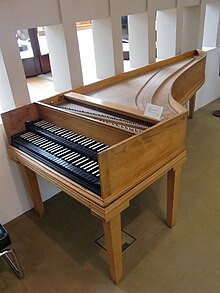Johann Christoph Oesterlein
Johann Christoph Oesterlein (* 1727 in Berlin ; † 1792 there ) was a German musical instrument maker .
Life
In the second half of the 18th century, Oesterlein was one of the most famous instrument makers in Berlin. He mainly made grand pianos , which were very popular and produced in large numbers, but also string instruments. Around 1773 he built pianos with leather tangents as a novelty. In the case of the clavichord , the metal tongues standing on the back of the keys are called, which do not tear the strings like the quills of the keel wing , but strike.
In the Berlin Citizens Register of the Magistrate Archives there is the following entry for Oesterlein for 1760: 1760. MA, BERL. BÜRG. B., 8th XI., P. 427. JOHANN CHRISTOPH ÖSTERLEIN, / a musical instrument maker, and owner / owner, also local / citizen's son, LV v. 25. M. pr. Died in December 1792 in Berlin at the age of 65. Important piano maker and inventor of the leather tangents (by Ledebur 407). Also mentioned in 1772. Made very good pianos and also string instruments (by Ledebur 580).
Works
A two-manual harpsichord (Berlin 1792) by Oesterlein is on permanent loan from the Sing-Akademie zu Berlin in the Musikinstrumenten-Museum Berlin . It comes from the possession of Carl Friedrich Zelter and was probably used by Felix Mendelssohn Bartholdy for the first performance of the St. Matthew Passion by Johann Sebastian Bach after his death in 1829 in the Sing-Akademie. Mendelssohn Bartholdy directed the performance from the instrument.
See also
Individual evidence
- ^ Ernst Ludwig Gerber : New historical-biographical lexicon of the Tonkünstler , 3rd part, Leipzig 1813, column 606 f. in: Gottfried Eberle, Michael Rautenberg: The Sing-Akademie zu Berlin and its directors. Musical instruments of the Sing-Akademie zu Berlin and its directors. Attempt to take stock. (from Conny Restle ). State Institute for Music Research Prussian Cultural Heritage, Berlin 1998, p. 66
- ^ Meyers Konversationslexikon , author collective, Verlag des Bibliographisches Institut, Leipzig and Vienna, 4th edition, 1885-1892, 9th volume, p. 817 - piano (history, piano playing)
- ^ Curt Sachs : Music history of the city of Berlin up to the year 1800. Stadtpfeifer , cantors and organists at the churches of the city patronage together with contributions to the general music history of Berlin. Gebrüder Paetel, Berlin 1908. Reprint: Olms Hildesheim / New York 1980.
- ↑ Gottfried Eberle, Michael Rautenberg: The Sing-Akademie zu Berlin and their directors , pp. 65–69
| personal data | |
|---|---|
| SURNAME | Oesterlein, Johann Christoph |
| BRIEF DESCRIPTION | German piano maker |
| DATE OF BIRTH | 1727 |
| PLACE OF BIRTH | Berlin |
| DATE OF DEATH | 1792 |
| Place of death | Berlin |
